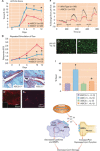ASICs Mediate Pain and Inflammation in Musculoskeletal Diseases
- PMID: 26525344
- PMCID: PMC4747907
- DOI: 10.1152/physiol.00030.2015
ASICs Mediate Pain and Inflammation in Musculoskeletal Diseases
Abstract
Chronic musculoskeletal pain is debilitating and affects ∼ 20% of adults. Tissue acidosis is present in painful musculoskeletal diseases like rheumatoid arthritis. ASICs are located on skeletal muscle and joint nociceptors as well as on nonneuronal cells in the muscles and joints, where they mediate nociception. This review discusses the properties of different types of ASICs, factors affecting their pH sensitivity, and their role in musculoskeletal hyperalgesia and inflammation.
©2015 Int. Union Physiol. Sci./Am. Physiol. Soc.
Conflict of interest statement
No conflicts of interest, financial or otherwise, are declared by the author(s).
Figures



References
-
- Akopian AN, Chen CC, Ding Y, Cesare P, Wood JN. A new member of the acid-sensing ion channel family. Neuroreport 11: 2217–2222, 2000. - PubMed
-
- Andersson G, and American Academy of Orthopaedic Surgeons. The Burden of Musculoskeletal Diseases in the United States: Prevalence, Societal, and Economic Cost. Rosemont, IL: American Acad. of Orthopaedic Surgeons, 2008.
-
- Askwith CC, Wemmie JA, Price MP, Rokhlina T, Welsh MJ. Acid-sensing ion channel 2 (ASIC2) modulates ASIC1 H+-activated currents in hippocampal neurons. J Biol Chem 279: 18296–18305, 2004. - PubMed
Publication types
MeSH terms
Substances
Grants and funding
LinkOut - more resources
Full Text Sources
Other Literature Sources
Medical

